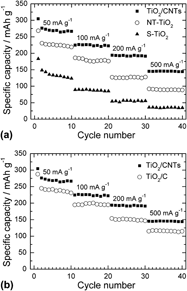Crossref Citations
This article has been cited by the following publications. This list is generated based on data provided by
Crossref.
Chen, Chaoji
Hu, Xianluo
Wang, Zhaohui
Xiong, Xiaoqin
Hu, Pei
Liu, Yang
and
Huang, Yunhui
2014.
Controllable growth of TiO2-B nanosheet arrays on carbon nanotubes as a high-rate anode material for lithium-ion batteries.
Carbon,
Vol. 69,
Issue. ,
p.
302.
Pan, Hui
2014.
Nanofabrication and its Application in Renewable Energy.
p.
121.
Liu, Jinlong
Feng, Haibo
Jiang, Jianbo
Qian, Dong
Li, Junhua
Peng, Sanjun
and
Liu, Youcai
2014.
Anatase-TiO2/CNTs nanocomposite as a superior high-rate anode material for lithium-ion batteries.
Journal of Alloys and Compounds,
Vol. 603,
Issue. ,
p.
144.
Qing, Rui
Liu, Li
Kim, Hansoo
and
Sigmund, Wolfgang M.
2015.
Electronic Property Dependence of Electrochemical Performance for TiO2/CNT Core-shell Nanofibers in Lithium Ion Batteries.
Electrochimica Acta,
Vol. 180,
Issue. ,
p.
295.
Zhang, Yanlin
Han, Changseok
Zhang, Geshan
Dionysiou, Dionysios D.
and
Nadagouda, Mallikarjuna N.
2015.
PEG-assisted synthesis of crystal TiO2 nanowires with high specific surface area for enhanced photocatalytic degradation of atrazine.
Chemical Engineering Journal,
Vol. 268,
Issue. ,
p.
170.
Liu, Yu
and
Yang, Yefeng
2016.
Recent Progress of TiO2-Based Anodes for Li Ion Batteries.
Journal of Nanomaterials,
Vol. 2016,
Issue. ,
p.
1.
Zhang, Liugen
Li, Hui
Xie, Hongtao
Chen, Tingxiang
Yang, Chao
and
Wang, Jide
2018.
MOF-driven ultra-small hollow Co9S8 nanoparticles embedded in porous carbon for lithium-ion batteries.
Journal of Materials Research,
Vol. 33,
Issue. 10,
p.
1496.
Cesano, Federico
Cravanzola, Sara
Rahman, Mohammed Mastabur
and
Scarano, Domenica
2018.
Interplay between Fe-Titanate Nanotube Fragmentation and Catalytic Decomposition of C2H4: Formation of C/TiO2 Hybrid Interfaces.
Inorganics,
Vol. 6,
Issue. 2,
p.
55.
Gusmão, Suziete B.S.
Ghosh, Anupama
Marques, Thalles M.F.
Gusmão, Gustavo O.M.
Oliveira, Tainara G.
Cavalcante, Luis Carlos D.
Vasconcelos, Thiago L.
Abreu, Guilherme J.P.
Guerra, Yuset
Peña-Garcia, R.
Santos, Francisco Eroni P.
and
Viana, Bartolomeu C.
2020.
Structural and magnetic properties of titanate nano-heterostructures decorated with iron based nanoparticles.
Journal of Physics and Chemistry of Solids,
Vol. 145,
Issue. ,
p.
109561.
Liang, Suzhe
Wang, Xiaoyan
Cheng, Ya-Jun
Xia, Yonggao
and
Müller-Buschbaum, Peter
2022.
Anatase titanium dioxide as rechargeable ion battery electrode - A chronological review.
Energy Storage Materials,
Vol. 45,
Issue. ,
p.
201.
El Halya, Nabil
Elouardi, Karim
Chari, Abdelwahed
El Bouari, Abdeslam
Alami, Jones
and
Dahbi, Mouad
2022.
Titanium Dioxide - Advances and Applications.
Parvin, Nargish
Merum, Dhananjaya
Mandal, Tapas Kumar
and
Joo, Sang W.
2023.
Tunable synthesis of bimetallic hybrid multishelled hollow structure for high-performance aqueous alkaline batteries.
Journal of Energy Storage,
Vol. 71,
Issue. ,
p.
108195.





